Reti gives the following position.
White to move
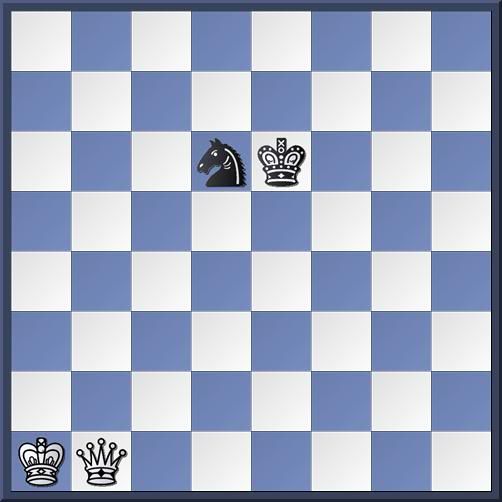
His solution is 1.Kb2 Kd5 2.Kc3 Ne4+ 3.Kd3 Nc5+ 4.Ke3 Ne6 5.Qf5+ Kd6 6.Ke4 Nc5+ 7.Kd4 Ne6+ 8.Kc4 Nc7 9.Qc5+ Kd7 10.Qb6 Ne6 11.Kd5 Nc7+ 12.Ke5 Ne8 13.Qe6+ Kd8 14.Qf7 Nc7 15.Kd6 Nb5+ 16.Kc6 1–0
Reti comments that queen versus a minor piece "is a simple win in all cases, regardless of the number of pawns that go with the piece" (569). I'm certain that we can create a position with enough pawns that the queen has a hopeless task, but sloppy prose aside, Reti makes his point. The key, as he points out, is "exercising a modicum of caution." There is nothing quite like a knight forking queen and king that can ruin an otherwise elementary win.
In "Queen Against Pieces," posted yesterday, I commented on a game that reached the position below.
White to move
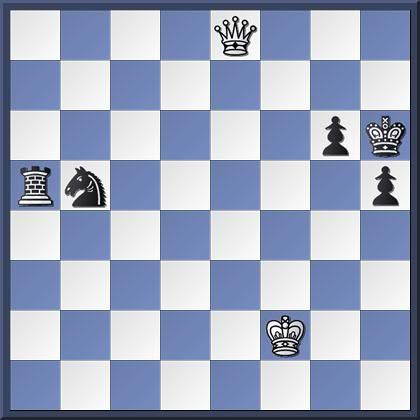
I had White and settled for a draw. This morning I played this position against Rybka 4 in order to practice the endgame that Reti claims can be won easily. Should I ever have a similar position again, even in a blitz game, I should win easily. Can I win this in thirty seconds? Ten? I started with ten minutes, but used barely three.
Stripes,James - Rybka 4 x64
Blitz 10m, Spokane 2011
1.Qh8+ Kg5 2.Qd8+ Kf4 3.Qxa5 Nd4
White to move

I presented this position yesterday as an analysis diagram. Here the practice begins.
4.Qd2+ Ke5 5.Qg5+ Nf5
White to move
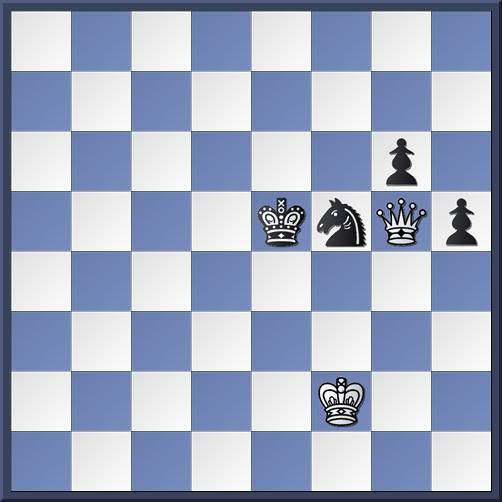
6.Ke2 Ke4 7.Qxg6 h4 8.Qg4+ Ke5 9.Kd3
Black to move
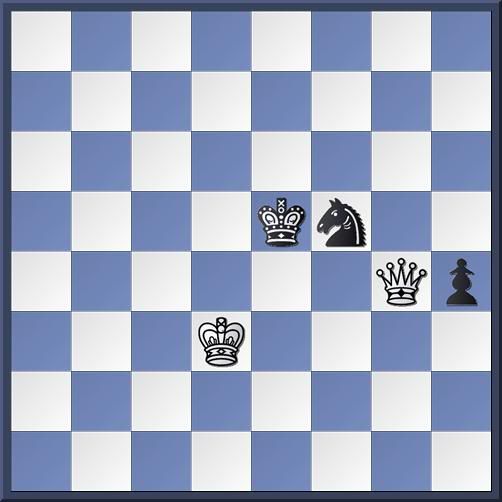
Black must lose the pawn. Then White systematically drives the king and knight towards the edge, eventually forcing the knight to leave the king's protection. Once this separation is achieved, the rest is a simple queen checkmate.
9...h3
9...Ke6 10.Ke4
10.Qxh3 Nd6 11.Qe3+ Kd5 12.Qd4+ Ke6 13.Qc5 Nf5 14.Ke4 Nd6+ 15.Kf4 Nf7
White to move

16.Qa5
I could have finished more efficiently with 16.Qb6+ Nd6 17.Qc6 Ke7 18.Ke5 Nf7+ 19.Kd5 Ng5 20.Qh6 Nf7 21.Qg7 Ke8 22.Ke6 Nd8+ 23.Kf6 Nf7 24.Qxf7+
16...Nd6 17.Qe5+
I missed 17.Qa2+ Ke7 18.Qd5 Nf7 19.Qc6 Nd6 20.Ke5 Nf7+ 21.Kd5 Ng5 22.Qg6 Nf7 23.Qg7 Ke8 24.Ke6 Nd8+ 25.Kf6 Nf7 26.Qxf7+
17...Kd7 18.Qd5 Ke7 19.Ke5
19.Qc5 is better 19...Kd7 20.Ke5 Nc8 21.Qc2 Nb6 22.Qc1 Na8 23.Qh1 Nc7 24.Qb7 Kd8 25.Kd6 Ne8+ 26.Kc6 Nc7 27.Qxc7+
19...Nf7+ 20.Kf5 Nd6+
White to move
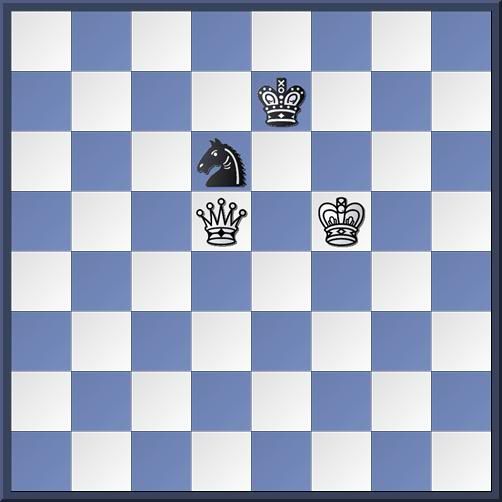
21.Kg6
I missed the more efficient 21.Kf4 Nf7 22.Qc6 Nd6 23.Ke5 Nf7+ 24.Kd5 Ng5 25.Qh6 Nf7 26.Qg7 Ke8 27.Ke6 Nd8+ 28.Kf6 Nf7 29.Qxf7+
21...Kd7
21...Ne8 does not help much 22.Qf7+ Kd8 23.Qh7 Kc8 24.Kf5 Nc7 25.Ke5 Kd8 26.Kd6 Nb5+ 27.Kc5 Na3 28.Qg7 Ke8 29.Kd6 Nb5+ 30.Ke6 Nd4+ 31.Qxd4
22.Kf6 Kc7 23.Ke7
Faster is 23.Ke6 Nb7 24.Qb5 Nd8+ 25.Kd5 Nf7 26.Qe8 Ng5 27.Kc5 Ne4+ 28.Qxe4
23...Nc8+ 24.Ke6 Nb6
24...Kb6 is no salvation 25.Qd8+ Kc5 26.Qxc8+
White to move
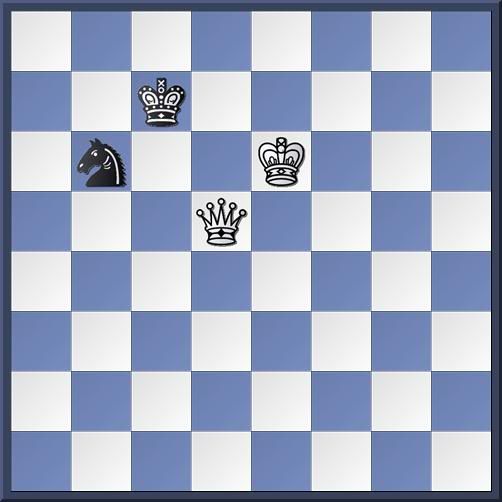
25.Qc5+
25.Qb5 is more precise 25...Nc8 26.Qd7+ Kb8 27.Qc6 Na7 28.Qa6 Nc8 29.Kd7 Na7 30.Qb6+ Ka8 31.Kc7 Nb5+ 32.Qxb5
25...Kb7 26.Kd6
Rybka 4 shows me the more efficient 26.Qd6 Nc8 27.Qd7+ Kb8 28.Qc6 Na7 29.Qb6+ Ka8 30.Kd7 Nc8 31.Qb3 Na7 32.Kc7 Nb5+ 33.Qxb5
26...Nc8+ 27.Kd7 Nb6+ 28.Kd8 Na4
White to move
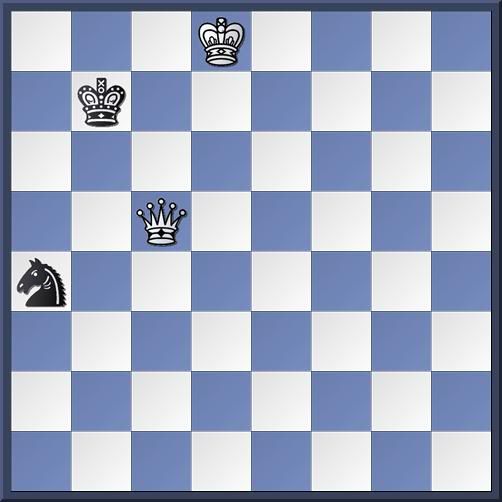
29.Qa5
Again, I might have played 29.Qc4 Kb6 (29...Nb6 30.Qb5 Ka7 31.Kc7 Nd5+ 32.Qxd5) 30.Qxa4
29...Kc6 30.Qxa4+ 1–0













No comments:
Post a Comment